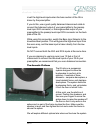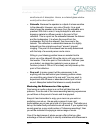
ver 1.0
13
1313
13
~ÄëçäìíÉ=ÑáÇÉäáíó™
The LFE input bypasses the internal crossover, and hence uses the
home theatre processor’s crossover. Since the G5 is able to play
down to 18Hz, the bass section can also be used as your Home
Theater System’s LFE sub-woofer if you do not have one – even if
you are using a completely different set of loudspeakers for your
home theatre system!
On the home theatre processor, set the speakers to “LARGE” and
sub-woofer to “YES” even if you do not have a separate sub-woofer.
Then, take the sub-woofer line-level output from the processor, and
plug it into the “LFE IN” connector on the G5.
If you are planning to use long runs (more than 10 feet) of
interconnects to connect the line-level LFE inputs of your G5 to
your processor, we suggest that you use the balanced XLR inputs.
For runs of interconnect less than 10 feet (3 metres), a single-
ended interconnect can be used.
LFE Gain
The G5 has a knob that controls LFE GAIN separately from the BASS
GAIN. This allows you to have the G5’s plugged both into your
audiophile stereo system as well as your home theatre system at the
same time without conflicts. The usual way to control the level of the
LFE output is to set the LFE gain to 6 – the twelve o’clock position –
and then use the home theatre processors level control to dial in the
level. However, having the LFE gain control allows you to tune the
LFE if your two systems have completely different gain structure.
LFE Output
Along with the LFE input, the G5 has a unique capability of LFE
output. This is a true powered buffered balanced output, and hence,
can convert a single-ended input signal into a true balanced output.
This buffered output can be used to daisy-chain the LFE signal to
other LFE inputs including other G5 speakers and separate
subwoofers.
Thus, it is possible to channel the LFE signal from your home
theatre processor to one speaker, and then from that speaker to
another, and to another, and to another!


















